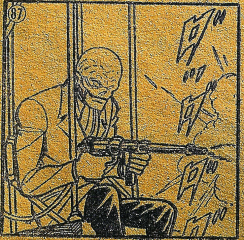I thought I'd share a little bit of info regarding my experiences with selling the
Miscellaneum of Cinder through
lulu.com and other related nonsense involving life as a self-published RPG author.
Today I got my first funds transfer from the lulu people, so I guess that officially makes me an RPG professional. Expect all my future posts to contain snide disregard for all you mere consumers. Actually, I want to offer a big "Thank You!" to everyone who paid money for my dumb little book. I know at least one buyer has actually used it in his campaign. If you've rolled on some
Miscellaneum tables for your own game, please share in the comments!
Lulu tells me that since offering the
Miscellaneum for sale on their site a total of 85 copies have been sold, 62 PDF downloads and 23 printed books. Thus I've already met my goal of selling more copies of the
Miscellaneum than the print edition of
Asteroid 1618, my
Encounter Critical adventure that was available for one month through S. John Ross's
Cumberland Games & Diversions lulu storefront.
At my pricing of one buck for the PDF and $5.50 for the hardcopy, I make 80 cents on each download and 9 cents on each book. That adds up to a total of $51.67 in gross profits. Since I got my buddy Pat to do all the illos for free, the net profit equals the gross profit. There's a lag time between sales and getting paid, so today's PayPal transfer was for the sales period ending 6/16. That amounted to $45.98.
I'd been eyeing this website called
Kiva.org since the beginning of the project. Kiva is a non-profit that facilitates micro-lending. The basic idea is that a bunch of sappy do-gooders each chip in some dough, which Kiva passes down a revenue stream to people normally unable to take advantage of modern financial services. The borrowers on the other end use the funds to try to bootstrap themselves out of poverty. For example, I put $25 in a pool totalling $650 that is going to a farmer in Viet Nam. She's borrowing money to buy livestock, trying to turn her subsistence farm into an economically viable commercial venture. Me and some other folks from all over the world have pitched in to give her a chance to do just that. Assuming she pays the money back (and the default rates for Kiva microloans are quite small) everyone gets their money back to either lend to another project or put back into the ol' PayPal account.
I also made a small donation to Kiva itself to help pay the cost of operations. My original plan had been to use some of the profits to buy
Jim Raggi's
Green Devil Face #1 and the new
Carcosa module
Obregon's Dishonor, but since coming up with those ideas
GDF has come off the market temporarily and I just got a review copy of
Obregon. That leaves about 17 bucks burning a hole in my PayPal account. Anybody care to make a recommendation?
So far I've received some nice comments on the
Miscellaneum but also one complaint. One fellow was dissatisfied with his PDF copy because the cover was omitted from the download. Have you

seen the front cover? I was suprised that anyone cared about it besides me.
When you put something up on lulu you upload the insides of the book and the covers as separate files. When you buy a download Lulu does not send the covers. This is probably why most everybody else I know lists downloads as separate items from the print version. That way they can upload a second copy with the covers incorporated into main file, but people who buy the print version don't end up with two covers. I sent the dude in question a PDF with the covers included, but right now I don't plan to change the storefront. If you want a PDF with the covers attached, please email me at jrients at the gmail to the dottity com.
Turns out a few other people cared about the cover. A couple weeks ago I approached
YourGamesNow.com about listing the
Miscellaneum with them. Not everybody likes Lulu and I thought I should find another channel for selling the PDF to those folks. YourGamesNow was the first PDF-only vendor I contacted because I like how they run their operation pretty much as a hippy commune of game vendors. Well, that came back to bite me in the ass, as apparently many of the commune members thought the cover was unacceptable. When I got the news, I was a little bit upset. Here were a bunch of people who I had assumed were fellow enthusiasts for the fine art of writing stupid crap about RPGs, yet they go and judge my book by its cover? I still think YGN is a nifty concept with a bunch of cool people involved, but that caught me off guard.
Not long after I put up the initial post announcing that the
Miscelleneum was for sale I got a very kind offer to do up a splashier cover for me. I got another such offer last week. But here's the deal: I am completely satisfied with the cover as it currently exists. That cover went through something like six full drafts and numerous minor tweakings. I decided on the top-to-bottom purple-to-whitish fade only after rejecting several shades of green, fades from left-to-right and vice-versa, a fade from purple to black, and a totally different take with a beige textured OD&D-esque thing going on. The font I used (also used for all the table headers) was based upon my own handwriting, but the font went through a couple drafts as well. And then I streched it vertically for the cover and outlined it, both of which needed a few attempts to get the effect just right. I didn't expect anyone but myself to appreciate these efforts, so I guess I shouldn't have been surprised when the cover cost me a spot at the YGN table.
So that's life with one toe on the bottom rung of the RPG business ladder. Glamorous, ain't it?






























































































































































.JPG)



































.png)

.png)

.jpg)





















.gif)






